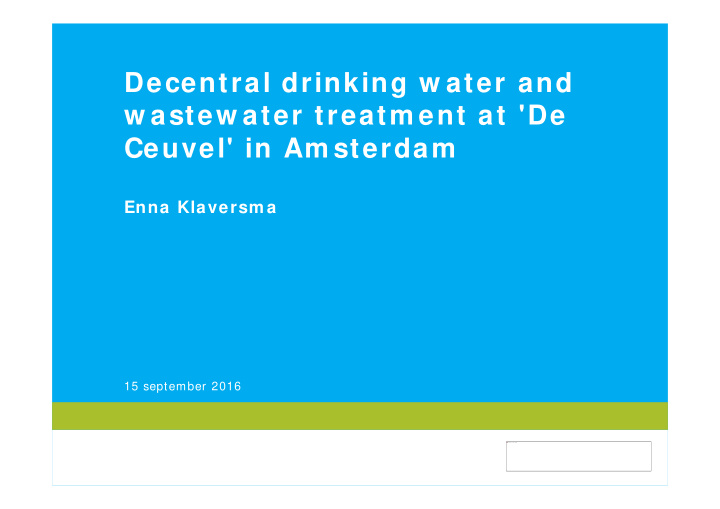



Decentral drinking w ater and w astew ater treatm ent at 'De Ceuvel' in Am sterdam Enna Klaversm a 15 september 2016 This image cannot currently be displayed.
I ntroduction Contents • Grey water treatment • Composting toilets • Local drinking water production • LCA • QMRA • Conclusion
Grey w ater treatm ent 5 L/ person/ day COD Total N Total P TSS ( concentrations in m g/ L) 401 14 1.9 43 Grey w ater influent Grey w ater effluent 122 6.8 1.6 37 Guideline 200 60 6 60
Com posting toilets Advantages Disadvantages 11 Months of composting No sewer needed (+ no flushing water) only Log 1.9 removal of Streptococci (WHO norm: Log 6 removal) Possibility of reuse Complaints by users (smell, compost discomfort with handling human waste)
Life Cycle Assessm ent • Goal: compare environmental impact of 1 m 3 drinking water; centrally (conventional) and locally (at De Ceuvel) • SimaPro software – EcoInvent 3.0 database – ReCiPe Endpoint method
LCA: results (Ecopoints/ m 3 drinking water)
Quantitative Microbial Risk Assessm ent • QMRA: risk below 1 per 10,000 persons per year norm Risk ( inf/ p* y) Surface water Grey water (in communal system) (in individual home system) 8.0 per 10 9 5 .0 per 1 0 3 Enterovirus 2.6 per 10 6 8 .8 per 1 0 4 Campylobacter 7.1 per 10 5 2 .7 per 1 0 4 Cryptosporidium 4.0 per 10 5 2.7 per 10 5 Giardia
Conclusions • Local loop closure hard to realize – Local grey water treatment is possible not to drinking water production – Not safe, higher environmental impact, high costs for monitoring – Composting toilets are no option, unless site without sewer
Questions? Discussion? ACKNOW LEDGEMENTS This research is co-financed with funding from the Topconsortia for Knowledge & Innovation (TKI) of the Dutch Ministry of Economic Affairs
Recommend
More recommend